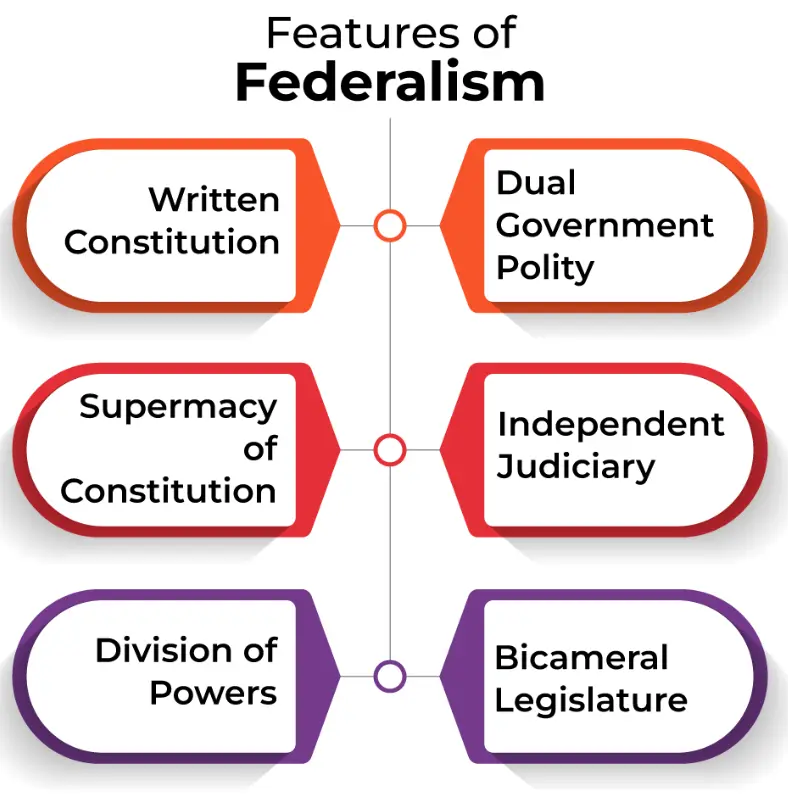Introduction
Federalism is a system of governance in which power is divided between a central authority and smaller political units, such as states or provinces. It ensures that both the central government and regional governments operate independently in their areas of jurisdiction while cooperating on shared responsibilities. This framework balances authority, addressing national concerns like defense and foreign policy, while empowering local governments to handle matters such as education, healthcare, and public safety.
Key features of federalism include a written constitution that outlines power distribution, multiple levels of government, and mechanisms to resolve disputes between central and regional authorities. Federalism fosters cooperation while preventing the concentration of power in one entity, making it suitable for large and diverse countries.
Also Read: Constitutional Safeguards to Civil Servants in India
Difference Between Indian and American Federalism

Although India and the United States are both federal nations, their systems vary significantly in structure and functioning due to their unique historical and political contexts.
Indian Federalism
Indian federalism is often described as “quasi-federal,” reflecting a unitary bias where the central government has greater control, especially in emergencies. The Indian Constitution divides powers into three lists:
- Union List: Subjects like defence, foreign affairs, and atomic energy are controlled exclusively by the central government.
- State List: Subjects like police, public health, and agriculture fall under state jurisdiction.
- Concurrent List: Both governments can legislate, but central laws prevail in conflicts.
The central government can impose President’s Rule in states and control significant financial resources, making states reliant on federal funding.
American Federalism
The U.S. federal system emphasizes decentralization, with states enjoying substantial autonomy, especially in areas not explicitly assigned to the federal government. The Tenth Amendment reserves powers not delegated to the federal government for the states.
American states exercise independent authority over education, criminal law, and healthcare. The judiciary protects state rights through landmark rulings, while fiscal federalism ensures states have significant revenue-raising powers.
Key Differences
| Aspect | Indian Federalism | American Federalism |
|---|---|---|
| Constitution | Detailed (470 Articles), easier to amend | Brief (7 Articles), difficult to amend |
| Division of Powers | Centralized: Union, State, Concurrent Lists | Decentralized: Powers reserved to states unless specified |
| Judiciary | Favors central authority | Reinforces state autonomy |
| Emergency Powers | Central government can suspend state functions | Limited, subject to Congressional oversight |
| Fiscal Autonomy | States rely on central government for funds | States have significant independent financial powers |
| Form of Government | Parliamentary system with a Prime Minister | Presidential system with an independent executive |
| Citizenship | Single citizenship | Dual citizenship (State and Federal) |
Historical Evolution
In the U.S., federalism evolved from dual federalism to cooperative federalism, promoting collaboration between governments. Recently, “new federalism” has shifted some powers back to states. In India, federalism began with strong centralization to maintain unity. The rise of regional parties has encouraged more cooperative federalism, but the central government retains significant power, particularly during emergencies.
Also Read: Doctrine of Prospective Overruling
FAQs
1. Why is Indian federalism called “quasi-federal”?
Indian federalism is described as quasi-federal because it combines federal features with a strong unitary bias. The central government holds overriding authority, especially during emergencies, making the system more centralized than traditional federal models.
2. How do states in the U.S. and India differ in fiscal autonomy?
U.S. states have substantial fiscal autonomy, raising revenue independently through taxes and other means. Indian states, however, rely heavily on central government allocations, which limits their financial independence.
3. What is the role of the judiciary in federal systems?
In the U.S., the judiciary protects state autonomy through rulings that limit federal overreach. In India, the judiciary often supports central authority, ensuring national unity while resolving center-state disputes.
Conclusion
Indian and American federalism represent distinct approaches to balancing central and regional authority. While the U.S. emphasizes decentralization and state autonomy, India’s system is designed to maintain unity in a diverse nation through central control. Both models, despite their differences, have proven effective in addressing the governance needs of their respective countries.
Reference: blog.ipleaders.in